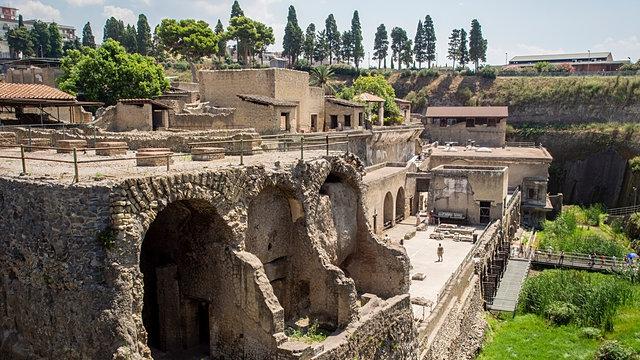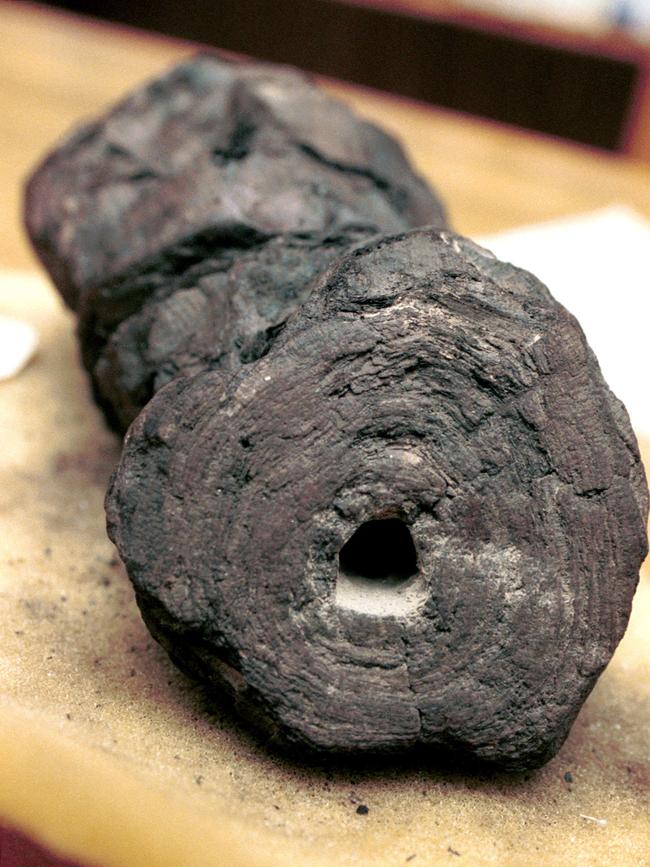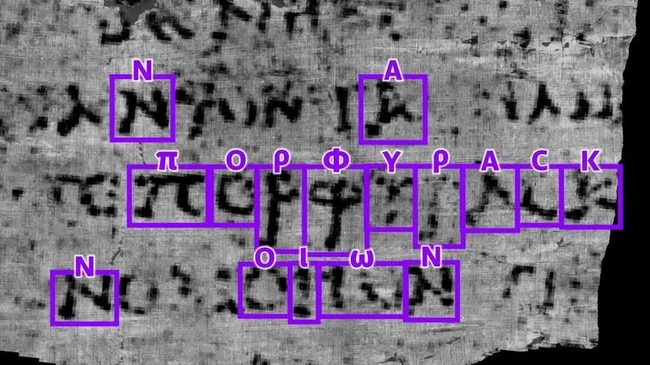Decoding the ancients buried by Vesuvius
Experts and students chasing a cash prize can finally decipher scrolls charred by Vesuvius.

Luke Farritor, a student at the University of Nebraska-Lincoln in the US, was walking home from a party a couple of months ago when his phone pinged.
In a sense, he’d received a message from ancient Rome. Back in his college room he’d left an artificial-intelligence system running on his computer. It was analysing a relic of one of history’s most infamous natural disasters – a papyrus scroll that had been transformed into brittle black charcoal when Mt Vesuvius erupted in AD79 and the volcano swallowed up the town of Herculaneum and the nearby city of Pompeii.
It would be impossible to unroll the carbonised scroll without it crumbling in your hands. Yet as Farritor, 21, peered at his smartphone screen, a fragment of text from its inner layers – part of the word Greek word porphyras, which means purple – was clearly visible. He had two reasons to be cheerful: he was the first person to set eyes on the Greek characters in nearly 2000 years and he had just won $US40,000 ($60,000) in a competition that may transform our knowledge of antiquity.
The lost library
The most splendid of all the properties entombed by the ash and rock unleashed by Vesuvius was a sprawling summer home in Herculaneum, possibly built by Lucius Calpurnius Piso Caesoninus, a wealthy aristocrat and father-in-law to Julius Caesar.
After its discovery in 1750, the Villa of the Papyri was found to contain the largest collection of classical sculpture ever seen in a single building. It also boasted the only intact library we have from the Greco-Roman world. Hundreds, possibly thousands, of scrolls have been preserved, but in a form that has been unreadable.
During the eruption, the scrolls were converted into withered ingots of pitch-black carbon.
“They look like lumps of coal,” says Brent Seales, a computer scientist at the University of Kentucky, who has been working on how to read them for 18 years.
Painstaking attempts were made to peel or scrape away layers of charred papyrus to read their contents. But the process was destructive. Piece by piece, the library was being obliterated.
For poet William Wordsworth, as for generations of archaeologists, the carbonised texts were fascinating and frustrating in equal measure. In September 1819 he invokes the ruins of Herculaneum and speaks of longing to unroll just one “precious, tender-hearted scroll”.

Robert Fowler, a classicist at the University of Bristol, says: “My personal wishlist would be the poetry of Sappho and some of the lost plays of Sophocles. And on the Latin side, the lost books of Livy, the Annals of Aeneas.”
Pliny the Elder, a Roman admiral and scholar who died during the eruption of Mt Vesuvius, lived just across the Bay of Naples.
Richard Carrier, a historian, has suggested the villa’s library may have kept a copy of his lost History of Rome. Could it contain a lost Homeric epic? Unknown science treatises? Works from Ovid? New letters from St Paul?
Fowler says it would be amazing to find early Christian texts, adding: “It seems less likely, but it’s true that the library was being added to in the first century AD. It could transform what we know about antiquity.”
Reading a book you can’t open
The quest to read the scrolls has been led recently by Seales, a pioneer in computer imaging. In the 1990s Seales worked at the British Museum, helping to make a digital copy of the earliest Beowulf manuscript, which had been damaged by fire. It was largely unscathed but a conservator also showed him a medieval codex that had been badly scorched before more harm was done by the water used to extinguish the flames.
Seales began to wonder: could it be possible to read works so badly deformed they can’t be opened?
After their discovery in the 18th century, Herculaneum scrolls occasionally were used as diplomatic bargaining chips. The Bodleian Library at the University of Oxford holds three.
In 2005 Seales travelled to Oxford to give a lecture. He suggested that the scrolls be scanned using computed tomography, a form of X-ray. By studying CT scans he believed it would be possible to distinguish the individual layers of rolled-up papyrus. The scans also should show the ink. Software developed by Seales then could be used to “flatten out” a virtual replica of a scroll, rendering it legible.
In 2016 he led a team that tested this technique on the En-Gedi scroll, an ancient carbonised parchment discovered in Israel in 1970. It worked beautifully, revealing it to be the beginning of the Book of Leviticus.

Three years later Seales gained access to two Herculaneum scrolls held by the Institut de France in Paris. They were taken to Diamond Light Source, a stadium-sized particle accelerator in Oxfordshire that produces a very fine, powerful X-ray beam. This allowed minutely detailed 3D scans to be made.
But the Herculaneum material represented a far tougher challenge. The ink used in the En-Gedi scroll had contained a dense material, possibly a metal, that stood out in X-ray images. By contrast the Herculaneum scribes had applied a carbon-based ink to papyrus, itself plant-based – and therefore carbon-based – material.
To pick out the writing, carbon had to be distinguished from carbon. CT scans alone could not do that. A new approach was needed.
It came when a Silicon Valley investor picked up a children’s book about the ancient world. Seales and his team used a particle accelerator to produce 3D scans of the Herculaneum scrolls.
The prize master
Nat Friedman’s previous roles have included being chief executive of Github, a widely used platform for storing code and collaborating on software projects. He explains how his interest in antiquity was kindled in 2020 when he read 24 Hours in Ancient Rome. It wasn’t long before he stumbled on Seales’s work and the progress he had made in “flattening” the Herculaneum papyrus.
“I found it shocking that there was this preserved but unrecoverable library,” Friedman says.
If the scrolls were not too badly damaged and the scans were of a high resolution, he saw no reason why a form of AI known as machine learning could not be trained to identify the ink.
He tried to nudge wealthy individuals from Silicon Valley into funding Seales’s work. When that failed he took another approach. Friedman has built his career in the realm of open-source software, where code is shared and solutions are hammered out by like-minded collaborators. He decided to launch a competition.
Friedman chipped in $US100,000 towards the Vesuvius Challenge prize pot. His friend Daniel Gross, a former head of machine learning at Apple, put in another $US100,000. In total $US1.4m has been raised.
The biggest single prize is $US700,000, the largest bounty of its kind in archaeology, for identifying at least four separate passages of “continuous and plausible text”, each at least 140 characters long. The deadline is December 31.
Smaller prizes were offered for steps of progress. They included $US10,000 won by Casey Handmer, a former NASA physicist. He realised the ink on the main scroll resembled a charcoal banana and had a distinct texture.
Farritor, the Nebraska undergraduate, built on Handmer’s insight. He was able to train a machine-learning model, a form of AI, to find areas of ink with the “crackle” pattern, then used the crackles to refine his model. Within weeks the AI revealed sequences of letters.
The first word, porphyras, or purple, was soon confirmed by Youssef Nader, an Egyptian computer science student in Berlin, who won $10,000.
Unrolled, the scroll would be about 10m long, and its papyrus layers twisted. The main bottleneck in reading it now appears to be producing virtually flattened sections for the AIs to pore over. That task may be more heavily automated soon using other AI systems, including one being developed by Farritor.
When Seales saw the results, he says he wept. “The story here isn’t that we’ve been able to read one word. The story is that we opened up a channel to be able to read every word.” Meanwhile, the team of expert papyrologists recruited to verify the findings were agog, Friedman says. “Somebody put it nicely: we’re bringing the past into the present with the tools of the future,” he says.
Since securing his prize, Farritor says he has made more progress and he will probably spend the $40,000 on new computers to accelerate the work.
“I have a lot more text than just the word ‘purple’, as do other competitors,” he says. He gives himself a good chance of getting the results required to win the $US700,000 before the deadline and believes the project as a whole is on an exciting trajectory. “Can we extract an entire book? Now, obviously, that would be pretty great,” he says.
“And I think it’s quite doable.”
The Times


